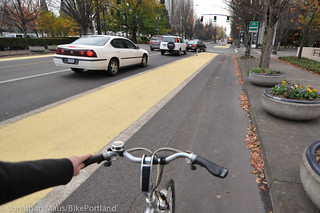
and more protection when they ride.
(Photo © J. Maus/BikePortland)
The Portland Bureau of Transportation is touting the success of their road diet and protected bike lane project on NE Multnomah Street in the Lloyd District. On their website today, PBOT announced results of a travel survey and bike count by the Lloyd District Transportation Management Association that shows significant increases in bike use compared to last year. The reason? A major design update on Multnomah that transformed the street from a 1970s-style, auto-dominated thoroughfare to a more modern cross-section that includes dedicated space for cycling.
Here’s more from PBOT:
One year after the NE Multnomah demonstration project was completed, bicycle commuting has increased over 25% in the Lloyd District. Based on the Lloyd Transportation Management Association’s 2013 annual survey of [TriMet] Universal Pass employees, bike commuting now represents 6.8% of all trips, up from 5.5% last year. The TMA has set a 10% bicycle commuting goal for Lloyd District employees.
Bike traffic has increased on NE Multnomah in 2013 following the construction of the demonstration project last fall. 265 bicyclists were counted traveling through the NE 7th & Multnomah Street intersection during the 2-hour count window this year, up 15% from the 2012 counts (231) and 32% from the 2011 counts (201). NE 7th Avenue and NE Multnomah have both been improved in the last few years with wider bike lanes and sections that are separated and/or bufferred from auto traffic.
PBOT is using this survey data as clear evidence that people who bike through the Lloyd District have begun using Multnomah specifically because of the protected bikeway and that “bicycle facilities in the Lloyd District are attracting new people to use bikes.”
In addition to the TMA’s data, as we reported on last week, the Oregeon Transportation Research and Education Consortium (OTREC) is also evaluating how the new configuration of NE Multnomah is impacting travel patterns. Following more surveys, video analysis and traffic counts, a determination will be made later this fall, “to decide the demonstration project’s future.”
How Multnomah works — and perhaps more importantly, how PBOT and the media spins whatever findings are revealed — could have a big impact on other projects throughout the city.
Speaking from personal experience, I have changed my route through the Lloyd in order to use Multnomah now that it has protected bike lanes. These new findings confirm that I’m not the only one.

